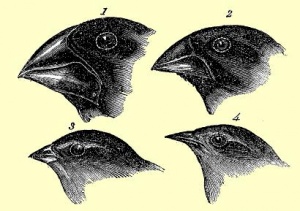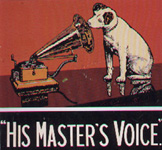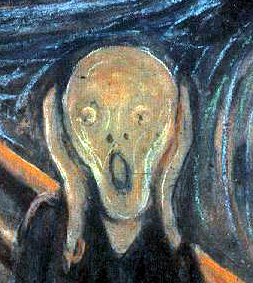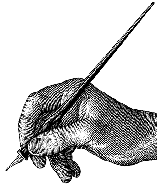Difference between revisions of "Classic Works in Evolutionary Biology"
KurtSchwenk (Talk | contribs) (→'''What is 'The Master List'?''') |
KurtSchwenk (Talk | contribs) (→'''What is 'The Master List'?''') |
||
| Line 21: | Line 21: | ||
The 'master list' is a list of classic works in evolutionary biology that I (Kurt Schwenk) compiled and partially annotated during the course of the semester. It was created based on my own choices, as well as suggestions from EEB colleagues and various web sources. Obviously there are potentially as many lists of 'classic works' as there are evolutionary biologists - this particular list is not intended to be definitive. It reflects, to some degree, my own personal interests and biases. However, an attempt was made to be inclusive; for example, there are a number of very important botanical references (thanks largely to Carl Schlichting), as well as obviously important works in population genetics, molecular biology and other areas I can hardly claim expertise in. As much as possible, I included only works that are generally important to evolutionary biology, as a whole, rather than the many papers that are of more circumscribed, if nonetheless critical, importance to a particular subdisciplines (e.g., phylogenetic analysis) or within a particular taxon (although I admit that a couple of important vertebrate papers somehow wandered into the list...). I excluded books and papers that are too recent. Thus, while there is no doubt that Schlichting and Pigliucci's ''Phenotypic Evolution'' (1998) (for example) will be considered a classic in the future, it is simply too recently published to have achieved this status now (I have added a separate section for such works, with the oxymoronic title, 'Modern Classics'). Finally, I note that several of the listed works are followed by a sublist of related papers that are, themselves, not necessarily 'classics', but are nevertheless helpful in appreciating the context or significance of the listed work. This is a type of emmendation/addition/annotation that would be particularly useful (see note below about annnotations).<br/><br> | The 'master list' is a list of classic works in evolutionary biology that I (Kurt Schwenk) compiled and partially annotated during the course of the semester. It was created based on my own choices, as well as suggestions from EEB colleagues and various web sources. Obviously there are potentially as many lists of 'classic works' as there are evolutionary biologists - this particular list is not intended to be definitive. It reflects, to some degree, my own personal interests and biases. However, an attempt was made to be inclusive; for example, there are a number of very important botanical references (thanks largely to Carl Schlichting), as well as obviously important works in population genetics, molecular biology and other areas I can hardly claim expertise in. As much as possible, I included only works that are generally important to evolutionary biology, as a whole, rather than the many papers that are of more circumscribed, if nonetheless critical, importance to a particular subdisciplines (e.g., phylogenetic analysis) or within a particular taxon (although I admit that a couple of important vertebrate papers somehow wandered into the list...). I excluded books and papers that are too recent. Thus, while there is no doubt that Schlichting and Pigliucci's ''Phenotypic Evolution'' (1998) (for example) will be considered a classic in the future, it is simply too recently published to have achieved this status now (I have added a separate section for such works, with the oxymoronic title, 'Modern Classics'). Finally, I note that several of the listed works are followed by a sublist of related papers that are, themselves, not necessarily 'classics', but are nevertheless helpful in appreciating the context or significance of the listed work. This is a type of emmendation/addition/annotation that would be particularly useful (see note below about annnotations).<br/><br> | ||
| − | {{pdf|https://hydrodictyon.eeb.uconn.edu/projects/classics/ClassicWorksMaster5_12_09.pdf}}'''Evolutionary Classics Master List''' (version 5/ | + | {{pdf|https://hydrodictyon.eeb.uconn.edu/projects/classics/ClassicWorksMaster5_12_09.pdf}}'''Evolutionary Classics Master List''' (version 5/12/09)<br/><br/> |
== '''A Comment on Modifying the Master List''' == | == '''A Comment on Modifying the Master List''' == | ||
Revision as of 05:05, 12 May 2009
Contents
- 1 What is This Page?
- 2 Who Can Access and Use This Page?
- 3 What is 'The Master List'?
- 4 A Comment on Modifying the Master List
- 5 Changing or Annotating the List
- 6 CLASSIC WORKS IN EVOLUTIONARY BIOLOGY WITH ANNOTATIONS AND LINKS TO PDFs
- 7 Modern Classics?
- 8 Questions About This Page?
- 9 Acknowledgments
What is This Page?
This page grew out of a graduate seminar taught in EEB during the spring semester, 2008, by Kurt Schwenk. The seminar was very successful—so successful, in fact, that one student was motivated to prepare a multi-media summary of what he learned. You can download his presentation HERE (Diego is appropriately modest about his achievement). There was a general consensus that it would be useful to graduate students and the EEB community at large to have continuing access to the papers and book selections that were read during the semester, as well as additional papers included in the master list of 'classic' works in evolutionary biology. Many of these pdfs are available in the list below.
Who Can Access and Use This Page?
Anyone can access this page, read its contents and even learn something. However, only members of the EEB community can edit the page and download pdfs for personal use. If you are a member of EEB, all you need to do is log in using your University Net ID and password. You can log in by clicking the tiny 'log in' link at the upper right corner of the page. Alternatively, you can click on a pdf icon or an 'edit' link and you will be directed to log in before proceeding. If you are a member of the EEB community and haven't done so already, please send Paul Lewis (Mr. EEBedia) your net ID (but not your password). Once you are on the 'acceptable' list, you have full access. Paul has created a system for this page and future course pages whereby it is not necessary to remember a username and password to access pdfs - it is all accomplished by logging in with your Net ID.
If you are a part of the UConn community with a Net ID, but not a member of EEB, and you wish to have full access to the list, you can make your case to Paul (paul.lewis@uconn.edu) for the addition of your Net ID to the user list.
What is 'The Master List'?
The 'master list' is a list of classic works in evolutionary biology that I (Kurt Schwenk) compiled and partially annotated during the course of the semester. It was created based on my own choices, as well as suggestions from EEB colleagues and various web sources. Obviously there are potentially as many lists of 'classic works' as there are evolutionary biologists - this particular list is not intended to be definitive. It reflects, to some degree, my own personal interests and biases. However, an attempt was made to be inclusive; for example, there are a number of very important botanical references (thanks largely to Carl Schlichting), as well as obviously important works in population genetics, molecular biology and other areas I can hardly claim expertise in. As much as possible, I included only works that are generally important to evolutionary biology, as a whole, rather than the many papers that are of more circumscribed, if nonetheless critical, importance to a particular subdisciplines (e.g., phylogenetic analysis) or within a particular taxon (although I admit that a couple of important vertebrate papers somehow wandered into the list...). I excluded books and papers that are too recent. Thus, while there is no doubt that Schlichting and Pigliucci's Phenotypic Evolution (1998) (for example) will be considered a classic in the future, it is simply too recently published to have achieved this status now (I have added a separate section for such works, with the oxymoronic title, 'Modern Classics'). Finally, I note that several of the listed works are followed by a sublist of related papers that are, themselves, not necessarily 'classics', but are nevertheless helpful in appreciating the context or significance of the listed work. This is a type of emmendation/addition/annotation that would be particularly useful (see note below about annnotations).
![]() Evolutionary Classics Master List (version 5/12/09)
Evolutionary Classics Master List (version 5/12/09)
A Comment on Modifying the Master List
A great advantage of using an EEBedia page for this purpose is that it can be edited and added to by the EEB community (thank you Paul Lewis!). However, I have a request - as much as I would like to see additions, changes, annotations, etc., I ask that a copy of the 'original' master list (i.e., the pdf linked above) be preserved. Thus, please modify the list posted below. Alternatively, you can create your own separate list - for example, you might want to create a 'classics' list for a particular subdiscipline, such as phylogenetics or behavioral evolution - and create a link to a separate pdf or a new EEBedia page. As such, the list posted below should not be modified for 'specialty' purposes. Additions should be carefully considered and restricted to books and papers the contributor feels are of genuine, general importance to evolutionary biology sensu lato.
The pdf version of the Master List will periodically be revised and the updated version uploaded to the link above. However, there will be periods of time during which the pdf version of the list does not correspond exactly to the 'editable' version below.
I request that you do not make deletions from the posted list without consulting me (Schwenk) first. While I accept that it might be a good idea to trim the list in some cases, I would prefer to err on the side of conservatism and make the decision to delete through consultation with colleagues. If there is a consensus that a particular work should be stricken fron the list, then it will be stricken! Conversely, if an addition is made to the list that causes widespread grumbling, it might be deleted.
If you make additions to the list, I strongly encourage you to upload pdfs of the new papers whenever possible. One of the principle purposes of this page, obviously, is to educate and one specific way to do this is to help graduate students preparing for their oral qualifying exams. Making sources easy to obtain would be a great service to students and other users. Obvioulsly not everything is available in electronic format, but often more is available than one might think and can be located by doing a Google search on the paper title (i.e., pdfs are sometimes available through web sources outside of JSTOR or other standard electronic databases; or in some cases there are entire books online so that a link can be provided) . Scanned documents are good, but watch out for memory hogs - there is a limit of 4 MB on documents uploaded to this page. If you have a document larger than that, or if you don't want to take the time to upload the paper yourself, feel free to send it to Schwenk for posting.
Changing or Annotating the List
Useful ways to modify the list:
- add an annotation - a summary or short note explaining the significance or context of the listed work (add your initials here and to the 'key')
- correct or add to an existing annotation
- add subsidiary/supplemental citations below a listed work if it helps inform about the work's importance (see examples)
- add a link to a site with a copy of the text or with supplementary information related to the listed work
- upload a pdf of the listed paper using the form link at the top of the list
- add a book or paper to the list (please do not do this casually - give it careful thought with regard to the comments above about the spirit of the list)
- create your own 'specialty list' of classics in a particular subdiscipine (e.g., vertebrate form and function) - create a new, linked EEBedia page or upload a pdf
- if you own a hard copy of a listed book or paper that is not available electronically and you are willing to loan it, indicate this with your last name in parentheses after the reference
FOR INSTRUCTIONS ON CREATING/EDITING EEBedia PAGES GO HERE
CLASSIC WORKS IN EVOLUTIONARY BIOLOGY WITH ANNOTATIONS AND LINKS TO PDFs
TO GO TO THE ANNOTATED LIST CLICK HERE
(the page was getting too unwieldy to remain undivided)
Modern Classics?
Gould, S. J. 2002. The Structure of Evolutionary Theory. Belknap/Harvard Univ. Press, Cambridge, MA.
[so massive it's got to be a classic... synthesizes all of Gould's favorite themes—theory, history, hierarchy, punc. equil., macroevolution, constraint, adaptation]
Schlichting, C. and M. Pigliucci (1998) Phenotypic Evolution. A Reaction Norm Perspective. Sinauer, Sunderland, MA.
[Carl intends to hang on long enough to see the day this is moved up to the main list... of course, he might take advantage of EEBedia's editing capacity to slip it up there late one night when no one is looking. Go HERE to buy it now! (KS)]
Schwenk, K., and G. P. Wagner (2004) The relativism of constraints on phenotypic evolution. Pp. 390-408. In: Phenotypic Integration: Studying the Ecology and Evolution of Complex Phenotypes. M. Pigliucci & K. Preston (eds.). Oxford Univ. Press, Oxford. PDF
[the absolute final word on evolutionary constraint—you can take my word on this (KS)]
Wagner, G. P., and L. Altenberg (1996) Complex adaptations and the evolution of evolvability. Evolution 50:967-976. PDF
[The merging of evolutionary biology and computer science. An extremely important paper on the evolution of evolvability through modularity at different hierarchical levels; introduces the terms genotype-phenotype map and variability, meaning 'the tendency to vary (as in 'solubility'). An absolute must-read for grad students with an evolutionary or evo-devo bent (KS)]
Questions About This Page?
Contact Kurt Schwenk (kurt.schwenk@uconn.edu) or EEB Webmaster, Paul Lewis (paul.lewis@uconn.edu)
Acknowledgments
This page would not be possible without the hard work of Paul Lewis who created and maintains EEBedia. Paul devoted considerable additional time to helping me learn the ins-and-outs of EEBedia and even modifying it to make the page do exactly what I wanted it to do. I also thank my colleagues who made suggestions of books and papers for inclusion in the Master List (even if, in the end, their nominations didn't make the final cut): Eldridge Adams, Andy Bush, John Cooley, Charlie Henry, Carl Schlichting, Chris Simon and Gregor Yanega. Finally, I thank the students in EEB 485, spring 2008, for their enthusiastic participation, advocacy of this web page and for teaching me a lot: Dave Hudson, Diego Sustaita, Rogerta Engel, Florian Reyda, Frank Smith, Jim Freyermuth, Jason Hill, Kat Shaw, Nic Tippery, Maria Pickering, Thiago Rangel, Tobias Landberg and Trina Schneider. --KS










